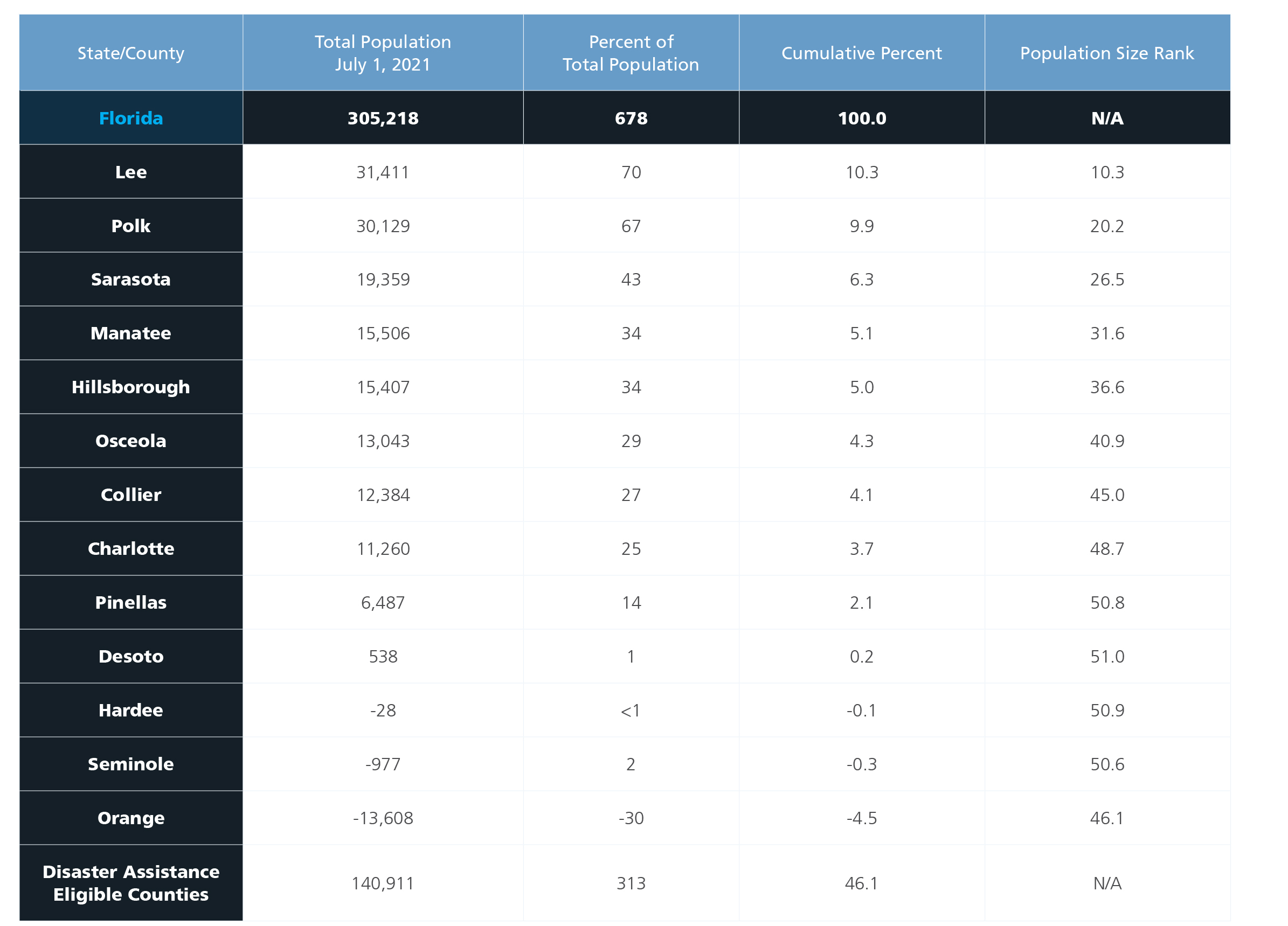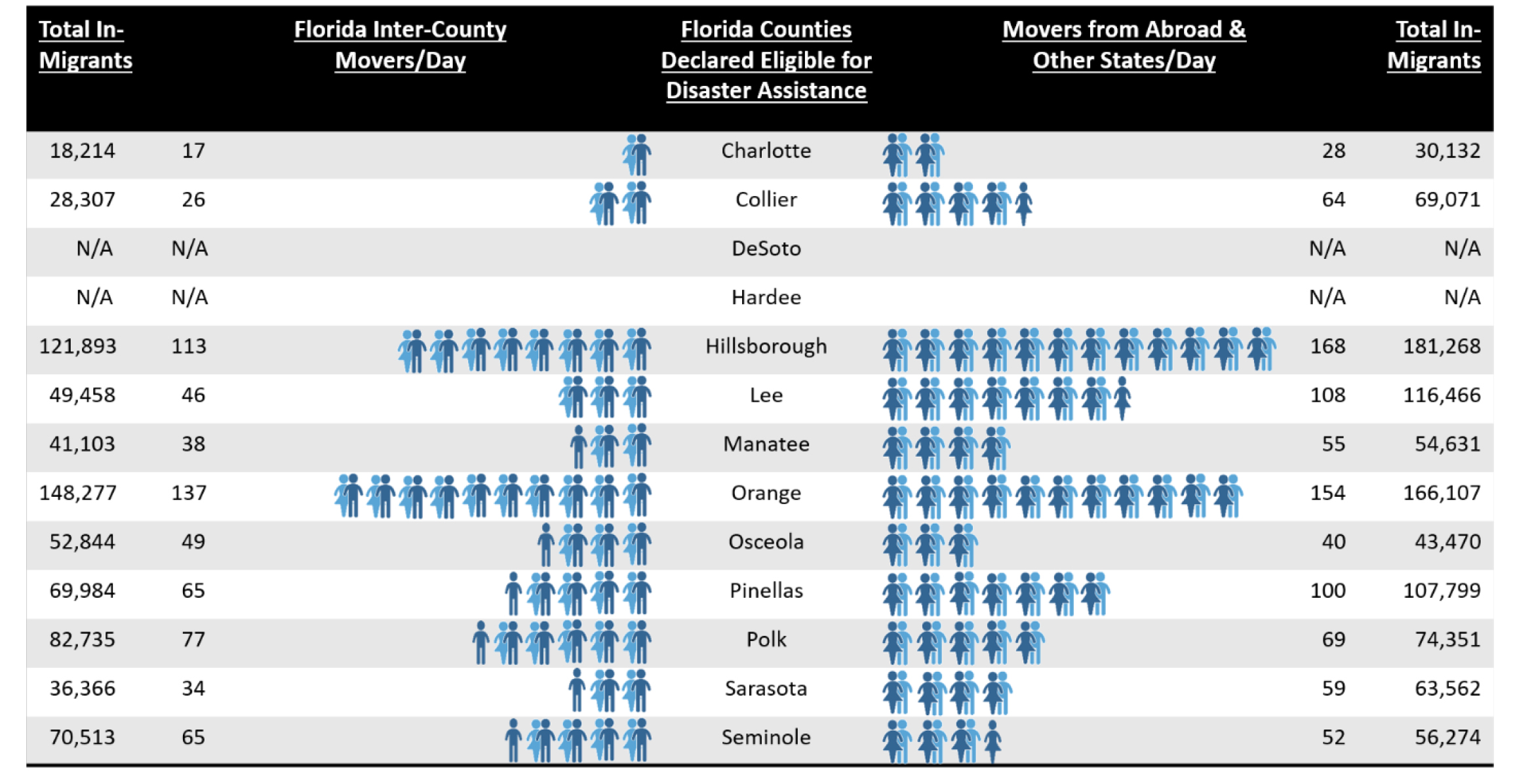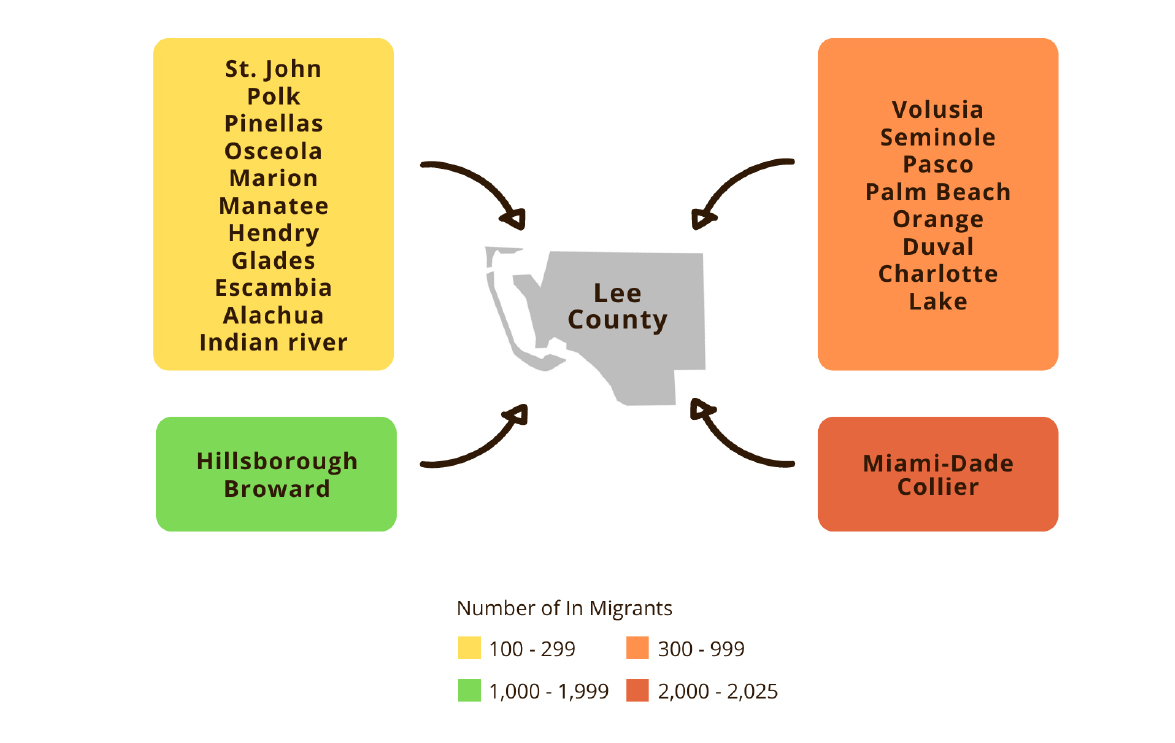Will Hurricane Ian Trigger Climate Refugee Migration from Florida?
White Paper by James H. Johnson Jr., Ph.D, Jeanne Milliken Bonds, MPA and Allan M. Parnell
Kenan-Flagler Business School UNC-Chapel Hill
May, 2023
ABSTRACT
Hurricane Ian destroyed property and disrupted livelihoods in some of Florida’s largest and most rapidly growing coastal and inland counties. For the thirteen counties declared eligible for federal disaster assistance in the immediate aftermath of this extreme weather event, we document the role net migration played in recent population growth—a crucial issue in climate change policy deliberations—and outline creative strategies and investments Florida officials will have to leverage to both rebuild and create resilient communities with reputational equity that remain attractive to newcomers as well as long term residents moving forward.
Introduction
Thirteen of Florida’s counties were declared eligible for federal disaster relief following Hurricane Ian’s disastrous trek through the state (The White House, 2022). The human toll and economic impact are still unfolding. According to the latest estimates, Ian left in its path more than 100 deaths and property damage and loss currently estimated at $100 billion (Gerretsen, 2022; Bizouati-Kennedy, 2022; Barker, 2022; Deliso and Kekatos, 2022). Making matters worse, an untold number of households and businesses in some affected Florida communities reportedly did not have insurance coverage for flood-related damages and losses, making rebuilding extremely difficult, if not impossible, for some victims–federal disaster assistance notwithstanding (Ivanova, 2022; Santana & Philis, 2022).
Extreme weather events like Hurricane Ian are increasing in both periodicity and intensity. Scientific evidence points to climate change as the major culprit (IPCC, 2022; Vince, 2022; Wallace-Wells, 2022; Watson, 2022; Wheeling, 2021). Here in the U.S., one writer asserts, “…people have largely gravitated toward environmental danger, building along coastlines from New Jersey to Florida and settling across the cloudless deserts of the Southwest” (Lustgarten, 2020; also see Korducki, 2022). Recognizing attraction to vulnerable areas, multiple studies offer critical insights into the likely impact extreme weather events—and climate change generally—will have on future migration behavior of affected populations and resulting settlement patterns–domestically and globally (The White House, 2021; Voegele, 2021; Podesta, 2019; Peterson, 2022; Lusgarten, 2020a; Kahanna & Hassol, 2021; Henao, 2022; Hauer, 2017; Bermeo & Speck, 2022; Backman, 2022; Post, et al, 2009).
For jurisdictions that are highly vulnerable to extreme weather events—not only hurricanes but also tornadoes, tropical cyclones, floods, heat waves, wildfires, droughts, and blizzards—the financial, economic, environmental, and geo-political ramifications are far ranging and in many ways difficult to comprehend or imagine (Lefebvre, 2021; Lustgarten, 2020b; Peterson, 2022; Quin, Fisher-Vanden & Klabier, 2018; Vince, 2022; Voegele, 2021; WallaceWells, 2022). As one study put it, “[a] great upheaval is coming,” noting further that “[t]hat the climate crisis has already uprooted millions in the US—in 2018, 1.2 million were displaced by extreme conditions, fires, storms, and flooding; by 2020, the annual toll had risen to 1.7 million people.” The study concludes, “The US now averages a $1bn disaster every 18 days” (Vince, 2022).
Research Objective
In this paper, we undertake an analysis of recent population trends in the thirteen Florida counties declared eligible for federal disaster assistance following Hurricane Ian. Our objective is to demonstrate specifically how migration influenced both the scope and scale of the disaster. Our analysis is based on data compiled in the U.S. Census Bureau’s American Community Survey, 2020 Census, and cumulative population estimates for the period April 1, 2020 – July 1, 2021—a period of heightened migration in the U.S. due to the COVID-19 pandemic and disastrous wildfires in the western U.S. (Johnson, 2021; Wallace-Wells, 2022). Our findings underscore the urgent need for Florida officials to simultaneously (1) develop expertise in climate finance—strategic knowhow to leverage weather-related pre-disaster planning and post-disaster lending, investments, and services; and (2) intentionally and purposefully address climate change by modifying land-use and community economic development policies and practices with an eye toward minimizing the impact of future calamities.
Affected Counties
Six of the hardest hit Florida counties were amenity rich but fragile coastal ecosystems, highly vulnerable to both strong winds and storm surge. The other seven hard-hit counties were in the interior of the state (Figure 1). The counties are at risk of major flooding and wind damage. Despite these environmental risks and vulnerabilities, the thirteen highly impacted counties are home to a significant share of Florida’s population and were some of the state’s most rapidly growing communities– often marketed in flashy promotional materials as “nirvana” destinations and “paradise” living environments.

In July 2021, according to post-2020 Census population estimates, the thirteen counties declared eligible for disaster assistance in the aftermath of Hurricane Ian were home to 7.8 million people, more than one-third of Florida’s total population (21,781,128). Looking through the lens of population size, five of these most adversely impacted counties ranked in the top ten, eight in the top fifteen, and ten in the top twenty largest counties in the state of Florida. Among the state’s 67 counties, the remaining three highly impacted counties ranked 28th (Charlotte), 49th (DeSoto), and 53rd (Hardee) in population size (Table 1).
Table 1: Absolute Population & Percent of State Total Population, Federal Disaster Assistance Eligible Florida Counties, July 1, 2021

Not surprising, the hurricane-impacted counties were also were among the most rapidly growing counties. Florida experienced a net population gain of 241,942 between April 1, 2020 and July 1, 2021. As Table 2 shows, ten of the thirteen counties declared eligible for federal disaster assistance in the aftermath of Hurricane Ian captured well over half (57.5%) of this net growth.
Three of the adversely impacted counties–Polk, Lee, and Hillsborough–ranked number one, two, and five, respectively, in absolute and relative population growth. Five of the remaining affected counties ranked sixth (Osceola), eighth (Sarasota), ninth (Manatee), twelfth (Collier), and fifteenth (Charlotte) in growth. Two of the adversely impacted counties captured a very small share of the net growth (DeSoto and Hardee) and therefore, like the three impacted counties that lost population during this period (Seminole, Pinellas, and Orange), were not among the state’s top 15 population growth magnets (Table 2).
Table 2: Cumulative Population Change, State of Florida & Federal Disaster Assistance Eligible Counties, April 1, 2020-July 1, 2021

Figure 2: Absolute and Total Population Change, April 1, 2020-July 1, 2021

Figure 3: Absolute and Total Population Change, 20102020

In many respects, this pattern of county-level growth between April 1, 2020 and July 1, 2021–the first fifteen months of the COVID-19 pandemic–was a continuation of the pattern of population growth during the previous decade in Florida. Growing at twice the national rate of growth (14.5% versus 7.4%), Florida’s population increased by 2.7 million between 2010 and 2020. Close to half of this growth (1.2 million) was concentrated in the thirteen counties declared eligible for federal disaster assistance following Hurricane Ian. Five of the six coastal counties and four of the seven inland counties affected by the hurricane grew more rapidly than the state in the prior decade. One county (Pinellas) grew more slowly than the state and two counties (Hardee and DeSoto) experienced population decline in the decade prior to the pandemic and the hurricane (Figure 3).
Migration as a Driver of Growth
Between April 1, 2020 and July 1, 2021, all of Florida’s population growth was driven by net migration, that is, more people entering than leaving the state. With a net gain of 305,218 migrants—an average of 678 net newcomers daily mainly from California, New York, and Illinois but also other states, Florida was the nation’s most attractive migration destination during this period (Figure 4). However, some of this migration-induced growth was offset by net natural population loss as deaths exceeded births in the state by -58,203, resulting in, as previously noted, net absolute population growth of 242,941.

The thirteen-county area that Hurricane Ian affected most adversely captured nearly half (46.2%) of this net migration. As Table 3 shows, ten of the impacted counties experienced net in-migration and three of the counties experienced net out-migration between April 1, 2020 and July 1, 2021.
Table 3: Absolute and Net Migration Per Day, Disaster Assistance Eligible Counties, April 1, 2020-July 1, 2021

Among the counties experiencing net in-migration, Lee and Polk were the top two migrant destinations, each gaining over 30,000 newcomers, followed by Sarasota, Manatee, and Hillsborough counties where between 15,000 and 19,000 net newcomers settled during this period. Charlotte, Collier, and Osceola received between 11,000 and 13,000 net newcomers while a smaller number arrived in Pinellas (6,487) and DeSoto (528) counties during this 15-month period.
Average net newcomers per day is an even stronger indicator of the role that migration played in shaping the size and composition of the affected counties prior to the hurricane (Table 3, column 3). Between April 1, 2020 and July 1, 2021, Lee and Polk counties averaged, respectively, 70 and 67 net newcomers per day; Sarasota, Manatee, and Hillsborough counties averaged between 34 and 43 migrants per day; between 14 and 29 net newcomers arrived in Pinellas, Charlotte, Collier, and Osceola each day; and one newcomer arrived in DeSoto County every day during this fifteen month period.
Figure 5 expands the time frame to further demonstrate how net migration shaped these Hurricane Ian impacted counties. For the period 2019-2021, these counties were attractive migration destinations for movers within Florida, movers from other states, and movers from abroad. Orange and Hillsborough standout as popular destinations for both Florida inter-county movers and movers from other states and abroad. Polk, Seminole, and Pinellas also standout as major destinations for inter-county movers. And Lee County was popular among movers from other states and abroad.
Figure 5: Total & Absolute Number of In-Migrants Per Day, Hurricane Impacted Communities, 2019-2021

To illustrate the demographic reach of the affected counties, we highlight migration flows into Lee County, the hardest hit jurisdiction during the hurricane. As Figures 6 and 7 show, there were major migration flows into Lee County from twenty three counties within the state of Florida and from twenty five communities in other states, including New York, New Jersey, Pennsylvania, and Connecticut in the Northeast; Maryland, Georgia, and Kentucky in the South; Ohio, Indiana, Illinois, Michigan, and Wisconsin in the Midwest; and Arizona and California in the West. The out-of-state flows were part of a longstanding retiree migration to Florida but also included COVID-19 pandemic refugees who fled densely settled major urban centers where the risk of exposure to the deadly virus was perceived to be much higher, especially in the early phase of the crisis. The within state moves were probably primarily individuals voting with their feet to take advantage of business and employment opportunities in this rapidly growing retirement destination.
[Figure 6]

[Figure 7]

An effective disaster recovery plan must account for these differing demographic characteristics and the underlying disparities that exist across the six coastal and seven inland counties (Hauer, 2017). Demographic differences and disparities, we should note, that are rooted—at least partly–in a prior extreme weather event.
Discussion and Recommendations
A significant share of the residents of the thirteen counties declared eligible for federal disaster assistance after Hurricane Ian are transplants to Florida. They include some recent movers who fled major urban centers in the Northeast, Midwest, and the West hoping to avoid or minimize the likelihood of exposure to the deadly COVID-19 virus (Johnson, 2021). Some were also fleeing wildfires in the West (Backman, 2022). Returning to the question posed at the outset: Will these individuals, other transplants to Florida, and long-term residents now become climate refugees, forced to move in response to Hurricane Ian and in fear of future climate changeinduced environmental disasters which are occurring with increasing frequency?
Only time will tell if the current crisis will motivate significant outmigration from impacted Florida communities (see, for example, BARC Staff, 2021). Asserting that prior disasters have not discouraged migrants from moving to Florida and settling in vulnerable communities, Lustgarten (2020b) notes that,
Since Hurricane Andrew devastated Florida in 1992—and even as [the] state has become a global example of the threat of sealevel rise—more than 5 million people have move to Florida’s shorelines, driving a historic boom in building and real estate.
However, in this specific instance, it is not unreasonable to think that some potential migrants may rethink moving to Florida and some local residents whose socio-economic wellbeing was disrupted by Hurricane Ian—most notably those without any or adequate insurance to rebuild (Ivanova, 2022)–may indeed seek climate refuge in more “livable geographies” as adverse or extreme weather events repeatedly devastate vulnerable communities (Marandi and Main, 2021; Keenan, et al, 2018; Kotsonis & Stohr, 2022). These storms create major risks to the health and wellbeing of the residents as well as the financial viability of the impacted communities which suffer loss of infrastructure and tax base (Khanna, 2021; Hurdle, 2022; Lustgarten, 2020a; Korducki, 2022). And Florida currently is in a property insurance crisis (Ivanova, 2022; Santana and Phillis, 2022). Homeowners are paying the highest premiums in the country, property premiums are rising at a faster rate than in the rest of the country, and property insurance is increasingly unavailable (Gerretsen, 2022b).
If Florida communities are going to retain existing residents and increase the viability of its vulnerable communities, it will be necessary for local officials to move beyond reliance on federal disaster relief and increasingly unaffordable private insurance in the community rebuilding and restoration process. Instead they must develop expertise in climate finance and disaster recovery, that is, innovative approaches that leverage (1) lending partnerships between traditional banks and Community Development Financial Institutions (CDFIs); (2) Community Reinvestment Act (CRA) weatherrelated pre-disaster planning and post-disaster lending, investment, and services; and (3) innovative public-private collaborations.
The Community Reinvestment Act (CRA) of 1977 was implemented to encourage banks to financially invest in and meet the credit needs in areas with low-to-moderate income and historically underserved populations. The regulations specify lending, investment, and provision of financial services as the methods banks must use to meet their regulatory requirements for CRA. Typically, such communities are the most vulnerable and least likely to have the required resources to prepare for, adapt to, and recover from the physical damage/destruction and resulting economic impacts of extreme weather events.
In a 2019 study, the Federal Reserve Bank of San Francisco and Harvard University jointly explored the connection between climate adaptation and resilience. The research focused on the types of community resilience investments that may simultaneously qualify for CRA credits and help banks, community development organizations and local governments collaborate in better preparing communities for the adversities they will face going forward. The research revealed that 57 percent of U.S. counties with federal disaster declarations over the last 20 years contain at least one low- and moderate-income census tract, the measure for CRA, and that, on average, one in every two people impacted by a disaster in these counties has lived in a low- and moderate-income census tract—solid proof that the same communities that have faced long-term disinvestment now face extreme weather events (Keenan and Mattiuzzi, 2019).
The CRA regulations identify geographic areas receiving Major Disaster Declarations administered by the Federal Emergency Management Agency (FEMA) as potential recipients of financial institution lending, investment, and services. Banks may receive CRA credit for investments in stabilization, recovery, and revitalization of such areas—provided the investments are made during a 36-month period after the FEMA disaster designation date. An interagency document called the “Questions and Answers” (Q and As) jointly prepared by the staffs of the Board of Governors of the Federal Reserve System, Federal Deposit Insurance Corporation, and Office of the Comptroller of the Currency provides additional guidance to financial institutions and the public regarding community reinvestment activities that “will be presumed to revitalize or stabilize such a geography or area if the activity is consistent with a bona fide government revitalization or stabilization plan or disaster recovery plan” (Board et al. 2016, p. 48527). Simply put, pre-event investments mitigate risk and generate benefits, and using tools such as CRA can help communities pre-invest for resiliency. Post-disaster recovery can be achieved through revitalization and stabilization activities that match the pre-disaster planning.
If affected Florida communities are going to regain their status as attractive places to live, work, play, and do business, in conjunction with pre-investing for resiliency, local officials also will have to invest resources in developing greater reputational equity, especially given the noted disparities in the incidence of poverty—an indicator of inequities in population health and economic wellbeing–that exist between affected coastal and inland communities (Greenfield, 2022). Places striving to achieve reputational equity “embrace the social determinants of health at the individual or group level and the triple bottom line principles of sustainability at the organizational and community levels to ensure future viability, cohesiveness, resiliency, and prosperity” (Johnson and Bonds, 2021).
Notably, the social determinants of health are “…the conditions in which people are born, grow, live, work, and age” (Robert Wood Johnson Foundation County Health Rankings, 2020), which are rooted most often in local governmental policies, practices, and procedures that create advantage for some and disadvantage for others, leading to disparate community-level outcomes manifested most often along racial lines. And triple bottom line sustainability—a multi-tiered strategy designed to address the social determinants of health–is achieved through conscious and intentional efforts to protect people and the planet while generating profit (Johnson and Bonds, 2021).
At the community level, this translates into local government officials simultaneously striving to achieve:
Climate justice by instituting policies that minimize population exposures to environmental risks created by growth and development/redevelopment; 2. Social justice by leveraging climate/environmental injustices to create economic opportunities for historically marginalized populations; and 3. Economic justice by working diligently to generate equitable shareholder and stakeholder value in all economic development and community resiliency initiatives—typically through the creation of inclusive entrepreneurial and small business ecosystems.
Following audits of existing government policies and practices, a number of state and local jurisdictions across the U.S. have developed strategies and roadmaps for environmentally conscious, inclusive, and equitable development and redevelopment that local governmental officials in Florida can use as guides in their efforts to rebuild communities affected by Hurricane Ian (Johnson, McDaniel, & Parnell, 2018; Bonds, Burnett, & Sissman, 2018). And we have produced a checklist of policies, strategies, practices, procedures, and tactics that communities striving to achieve greater reputational equity typically pursue (Johnson and Bonds, 2021).
Moving quickly to develop community resiliency plans rooted in the core principles of equity, inclusion, and sustainability before a disaster is likely to enhance safety and wellbeing, reduce disaster-motivated migration intentions, and restore the image of affected communities as attractive migration destinations moving forward.
About the Authors
James H. Johnson, Jr. is the William Rand Kenan, Jr. Distinguished Professor of Strategy and Entrepreneurship in the Kenan-Flagler Business School and Director of the Urban Investment Strategies Center in the Frank Hawkins Kenan Institute of Private Enterprise at UNC-Chapel Hill.
Jeanne Milliken Bonds is a Professor of the Practice, Impact Investment and Sustainable Finance in the Kenan-Flagler Business School and the Department of Public Policy at UNC-Chapel Hill.
Allan M. Parnell is a Senior Research in the Kenan Institute’s Urban Investment Strategies Center and Vice President of the Mebane, NC-based Cedar Grove Institute for Sustainable Communities.
The Kenan Institute serves as a national center for scholarly research, joint exploration of issues, and course development with the principal theme of preservation, encouragement, and understanding of private enterprise.
Related Articles
Virginia’s Shifting Demographics and the Future Competitiveness of the Commonwealth
A Whole Community Health approach to Virginia’s rapid population growth over the past three decades and demographic challenges.
Real Estate Alert! Gale Force Demographic Wind Gusts Ahead
Newcomers from other states and abroad are principally responsible for North Carolina’s population boom–growth by 3.9 million– since 1990. However, seven powerful demographic disruptors—analogous to gale force wind gusts in an adverse weather event—can potentially quell future growth and demand for residential and commercial real estate. Strategies to circumnavigate the adverse effects of the demographic gale force winds ahead are discussed.
Business Alert! Gale Force Demographic Wind Gusts Ahead
Seven powerful demographic trends—analogous to gale force wind gusts in an adverse weather event—constitute potentially powerful disruptors of business and commerce in the years ahead. Four of the gale force demographic disruptors—slowing total and foreign-born population growth, white population loss, and declining fertility— have evolved over the past several decades.








